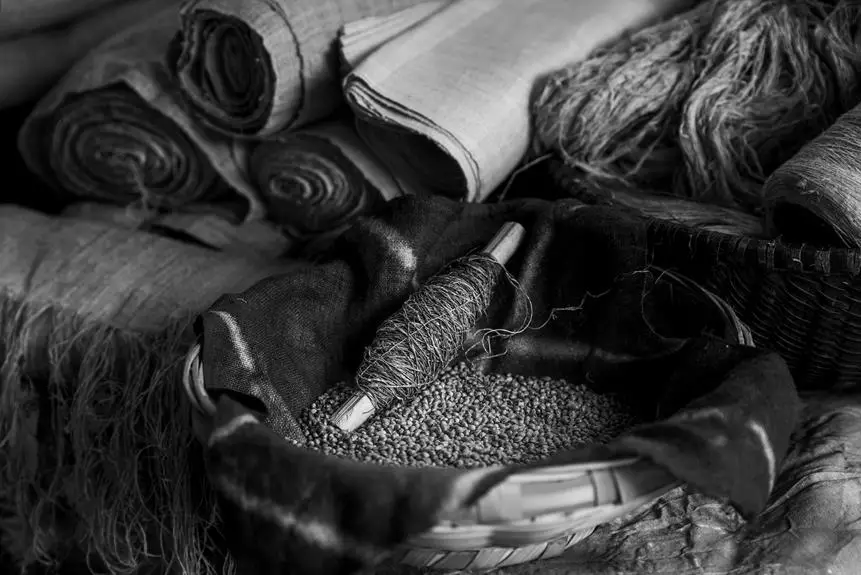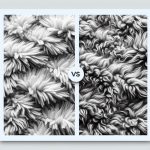When you touch microfleece, you'll notice its smooth and sleek surface, which feels different than the plush, fuzzy texture of Sherpa. Though both fabrics serve the purpose of providing warmth, their tactile qualities set them apart significantly. Microfleece's tightly woven fibers create a denser feel, while Sherpa's looped yarn gives it a soft, bulkier exterior. Understanding these differences in texture can guide your choice, but the implications for warmth, durability, and maintenance might surprise you. What else might you discover about these popular fabrics?
Table of Contents
Overview of Microfleece
Microfleece is a lightweight, synthetic fabric known for its softness and warmth, making it a popular choice for sweaters, blankets, and activewear.
You'll appreciate its versatility, whether you're lounging at home or embarking on outdoor adventures.
Microfleece is typically made from polyester, offering excellent insulation without the bulk.
This means you can stay comfortable in cooler temperatures without feeling weighed down.
One of the standout features of microfleece is its breathability.
Unlike heavier materials, microfleece allows moisture to escape, keeping you dry and comfortable during physical activities.
Additionally, it dries quickly, so if you sweat or get caught in light rain, you won't be left shivering.
When it comes to maintenance, microfleece is easy to care for.
You can toss it in the washing machine without worrying about shrinkage or damage.
Plus, its durability means it can withstand regular use, making it a wise investment for your wardrobe.
Overall, microfleece's combination of warmth, lightweight feel, and ease of care makes it an essential fabric for a variety of clothing and home essentials.
Embrace its qualities, and you'll find it hard to go back to heavier alternatives.
Overview of Sherpa
Sherpa is a cozy fabric that mimics the feel of wool, offering a plush texture and superior warmth, making it a favorite for jackets, blankets, and lined garments. Used widely in outdoor apparel, Sherpa provides an excellent insulation option, keeping you toasty on chilly days.
You'll find Sherpa in various designs, from reversible jackets to stylish throw blankets, adding a touch of luxury and comfort to any ensemble. Typically made from synthetic materials, it boasts durability, easy care, and resistance to fading, making it a practical choice for everyday use.
You'll also appreciate how lightweight Sherpa feels while still delivering incredible warmth. It's breathable, allowing air circulation, so you won't feel overheated while wearing it. Plus, the fabric's plush surface adds a delightful tactile element, enhancing your comfort experience.
Whether you're snuggling up on the couch or heading out for an adventure, Sherpa has your back. Its versatility caters to a wide range of styles and occasions, ensuring you stay fashionable and warm. Plus, it's an excellent option for lounging or layering, so you'll want to keep it in your wardrobe.
Texture Comparison
When comparing microfleece and Sherpa, you'll notice distinct differences in their fiber structures.
You'll find that softness and comfort levels vary significantly between the two materials, impacting how they feel against your skin.
Additionally, consider their durability and maintenance needs, as these factors play a crucial role in your overall experience with each fabric.
Fiber Structure Differences
Texture plays a crucial role in distinguishing microfleece's smoothness from Sherpa's plush, fluffy feel. To better understand how these materials differ, let's examine their fiber structures. Microfleece is made from tightly woven polyester fibers, giving it a sleek and velvety surface. In contrast, Sherpa's fiber structure consists of a thicker, more looped yarn that creates a soft, fuzzy exterior.
Here's a quick comparison of their fiber structures:
| Feature | Microfleece | Sherpa |
|---|---|---|
| Fiber Type | Tightly woven polyester | Thick, looped synthetic yarn |
| Surface Texture | Smooth and velvety | Plush and fluffy |
| Heat Retention | Moderate | High |
The differences in these fiber structures significantly affect how each material feels and performs. Microfleece is lightweight, making it ideal for layering without bulk, while Sherpa's bulkier design provides superior warmth, perfect for colder environments. By understanding these fiber differences, you can better choose what suits your needs.
Softness and Comfort Level
Microfleece offers a silky softness that's ideal for those who prefer a smooth touch against their skin, while Sherpa envelops you in its cozy, plush warmth. Both materials excel in comfort but cater to different preferences.
Microfleece feels sleek and lightweight; it barely clings to you. The texture of microfleece is often described as gentle, minimizing irritation even for sensitive skin.
Sherpa, on the other hand, has a thicker, more textured feel, reminiscent of a soft blanket or even soft lambskin. The deep pile of Sherpa provides an exceptional warmth, wrapping you in a comforting embrace.
When you wear microfleece, you might enjoy how it's breathable yet warm enough for chilly weather. Conversely, with Sherpa, you're likely to experience a sense of being cocooned, making it perfect for lounging on cold nights.
Ultimately, the choice between these two comes down to personal preference. Do you prefer a sleek, lightweight comfort or a thicker, cozier embrace? The answer will guide you in deciding which fabric aligns best with your comfort level.
Durability and Maintenance Needs
Both microfleece and Sherpa have their own strengths in durability and maintenance, impacting how easily you can keep them looking great over time. Microfleece is known for its resilience; it resists pilling and maintains its shape even after numerous washes. This makes it a low-maintenance option for your everyday needs. You can toss it in the washing machine, and it'll dry quickly, saving you time and effort.
On the other hand, Sherpa tends to be a bit more demanding. While it's incredibly durable, it can show wear and tear on its plush fibers over time if not cared for properly. You'll want to wash it on a gentle cycle and air dry it or use a low heat setting to preserve its softness and texture.
When considering maintenance, think about how often you'll be using the fabric. If you'll be using it daily, microfleece might be your best bet for easy care. However, if you're looking for a cozy texture and don't mind putting in a little extra effort, Sherpa could be a perfect choice. Balancing durability with your lifestyle can guide your decision.
Warmth and Insulation
Microfleece typically offers consistent warmth and insulation, making it a popular choice for layering during chilly weather. When you need to stay warm, microfleece's lightweight design traps heat effectively without adding bulk. This makes it easy to wear under jackets or sweaters, allowing you to enjoy flexibility while keeping cozy.
Key benefits of microfleece in terms of warmth include:
- It's breathable, so you won't overheat during physical activities.
- The fine fibers create insulating pockets of air, maintaining warmth.
- Microfleece dries quickly, helping you stay comfortable in damp conditions.
Sherpa offers a fluffier, thicker style that provides excellent insulation as well. While you may find it incredibly warm and inviting, it can be bulkier and may not layer as well under other clothing. When choosing between the two, think about your activity level and layering needs. Both fabrics have their advantages, but microfleece is your best bet if versatility and ease of wear are high on your list.
Durability and Maintenance
Considering longevity and care, microfleece typically holds up well against wear and tear, making it a practical choice for everyday use.
It's lightweight and has strong fibers, which means it's less likely to pill or fray over time. You can easily toss microfleece items in the washing machine without worrying about losing their shape or softness.
Just remember to use a gentle cycle and avoid high heat during drying to maintain its integrity.
On the other hand, Sherpa offers a cozy feel and looks great, but its maintenance can be trickier. While it's durable, the texture can trap dirt and require more careful cleaning.
You'll likely need special care to retain its fluffy quality, especially after multiple washes. If you don't mind putting in a bit more effort, Sherpa can still be a lovely option.
Ultimately, if you prioritize ease of care and resilience, microfleece is your best bet. However, if you're after plush comfort and don't mind regular upkeep, Sherpa might appeal to you. In either case, understanding maintenance needs will help you get the most out of your chosen fabric.
Choosing the Right Fabric
When choosing the right fabric, you want to consider comfort and softness first.
Next, think about breathability and warmth for your specific needs.
Comfort and Softness
Choosing between microfleece and Sherpa boils down to how each fabric feels against your skin and their unique warmth levels. Microfleece is known for its soft, smooth texture that often feels lighter and more delicate. It wraps you in a gentle embrace, making it a fantastic option for those who prefer a cozy but less bulky feel.
On the other hand, Sherpa offers a thicker, plush texture that mimics the warmth of wool. It feels wonderfully cushy, ideal for lounging around or staying toasty on colder days.
When deciding which fabric is right for you, consider these factors:
- Feel: Microfleece glides across your skin, while Sherpa provides that dense, comforting hug.
- Durability: Microfleece tends to hold its shape better, while Sherpa may show wear sooner.
- Weight: Microfleece is lightweight, making it perfect for layering, whereas Sherpa adds substance.
Ultimately, your choice will hinge on personal preference and how you plan to use the fabric.
Breathability and Warmth
Both microfleece and Sherpa offer distinct benefits in breathability and warmth, so it's essential to understand their properties before making your choice.
Microfleece is known for its lightweight and breathable nature. It wicks moisture away, keeping you dry while providing warmth without being overly stuffy. If you're looking for something to keep you cozy during those brisk outdoor activities, microfleece might be the better option.
On the other hand, Sherpa tends to be thicker and denser, offering excellent insulation. It mimics the feel of sheep's wool, making it incredibly warm and perfect for lounging on chilly evenings. However, it can be less breathable, which means you might feel a bit warmer than you'd like if you're active.
In choosing between the two, consider your activity level and the climate. If you want breathability for active use, microfleece could be your go-to. But if your priority is maximum warmth for relaxation, then Sherpa may be what you need. Think about how you'll use the fabric, and you'll be closer to selecting the right one for your needs.
Durability and Maintenance
Durability and maintenance are key factors to consider when selecting between microfleece and Sherpa for your wardrobe. Microfleece is known for its sturdiness; it resists pilling and retains its shape after multiple washes. This makes it an excellent choice if you want something that'll hold up over time with minimal care.
On the other hand, while Sherpa can provide a luxurious feel, it may require a bit more maintenance to keep it looking fresh.
Microfleece: Generally machine washable and quick-drying.
Sherpa: More prone to shedding; may need special washing care.
Microfleece: Lightweight and easy to pack for travel.
Sherpa: Offers a plush feel but can be bulkier to store.
Frequently Asked Questions
Can Microfleece Be Used for Outdoor Activities?
Yes, you can definitely use microfleece for outdoor activities. It's lightweight, moisture-wicking, and provides warmth without bulk. Just make sure it's suitable for the specific conditions you'll encounter during your adventures.
Is Sherpa Fabric Eco-Friendly?
Sherpa fabric isn't inherently eco-friendly, but some manufacturers create it using recycled materials. If you're looking for sustainability, check the brand's practices and consider alternatives made from organic or environmentally conscious fibers.
How Do Microfleece and Sherpa Feel Against the Skin?
When you touch microfleece, you'll notice it's soft and smooth, providing a lightweight feel. In contrast, sherpa feels plush and cozy, offering a thicker, fluffier texture that wraps you in warmth and comfort.
Are There Any Health Considerations for Using These Fabrics?
When using microfleece or sherpa, consider potential skin sensitivities and allergies. Both fabrics can trap heat and moisture, possibly leading to irritation. Ensure you choose breathable options if you're prone to skin issues or overheating.
What Are Common Uses for Microfleece and Sherpa?
Microfleece is great for activewear and blankets, while Sherpa works well for warmth in jackets and cozy throws. You'll find both fabrics popular in winter apparel, providing comfort and style during colder months.
- How Does Ring Spun Cotton Affect Garment Fit and Shape Retention? - August 13, 2024
- What Are the Challenges in Producing Ring Spun Cotton? - August 13, 2024
- Is Ring Spun Cotton Suitable for Plus-Size Clothing? - August 13, 2024







